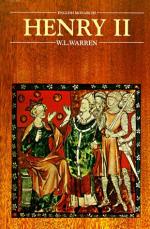CHAPTER V
THE CONSTITUTIONS OF CLARENDON
In the January of 1163 Henry once more landed in England. His absence off our and a half years had given time for dangers and alarms to spring up in the half-settled realm. Mysterious prophecies passed from mouth to mouth that the king would never be seen in the island again, and even Theobald, before his death in 1161, had sent urgent entreaties for his return. The king had, in fact, during the first eight years of his rule been mainly occupied in building up his empire, and providing for its defence against external dangers. He had only twice visited the kingdom, each time for little more than a year. He was now, however, prepared to take the work of administration seriously in hand. In the next eighteen years, from 1163 to 1180, he landed on its shores seven times, and spent altogether eight years in the country. Once he was busied with the conquest of Ireland; one visit of a month was spent in crushing a dangerous rebellion; but with these two exceptions every coming of the king was marked by the carrying out of some great administrative reform. In his half-compacted empire order was still only maintained by his actual presence and the sheer force of his personal authority, as he hurried from country to country to quell a rising in Gascony or a revolt in Galloway, to wage war in Wales, to finish the conquest of Britanny or of Ireland, to order the administration of Poitou or Normandy. But in the swift and terrible progresses of a king who visited the shires to north and south and west in the intervals of foreign war, a long series of experiments as to the best forms of internal government was ceaselessly carried out, and the new administration securely established.
Henry, however, was at once met by a difficulty unknown to earlier days. The system which the Conqueror had established of separate courts for secular and ecclesiastical business had utterly broken down for purposes of justice. Until the reign of Stephen much of the business of the bishops was done in the courts of the hundred and the shire. The Church courts also had at first been guided by the customary law and traditions of the early English Church, which had grown up along with the secular laws and had a distinctly national character. So long, indeed, as the canon law remained somewhat vague, and the Church courts incomplete, they could work peaceably side by side with the lay courts; but with the development




